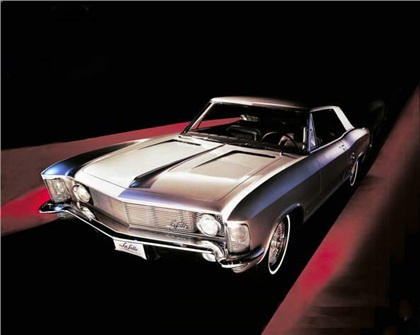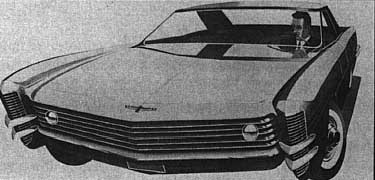Cadillac La Salle XP-715, 1961
The 1961 La Salle concept was also known as XP-715, following the
General Motors custom of assigning 'experimental' cars XP numbers.
Cadillac La Salle XP-715, 1961
The Buick Riviera was
introduced to the public on October 4, 1962, and immediately the Riviera
received approval as the most brilliant automobile to appear in years.
Automotive writers praised the car for its style, engineering and
handling. Unlike most of the new models, the Riviera had its beginning
in the styling studio, with little thought given to engineering
considerations. It wasn't until Buick was awarded the car did they have
to work out all of the mechanical problems without altering the shape.
But we're getting ahead of ourselves.
Cadillac La Salle XP-715, 1961
It should be said that the idea for a new personal luxury car at GM was
most likely influenced by the success of Ford's four-seat Thunderbird,
which was introduced in 1958. The new Thunderbird proved to be such a
phenomenal success, that GM president John E. Gordon realized the need
for GM to have something to compete. He looked to his styling studio and
his new chief stylist, William L. Mitchell, for ideas. Mitchell, who
was trained under Harley Earl, had a talented staff of designers
including Ned Nickles, who had created the 1949 Roadmaster Riviera,
Buick's first pillarless hardtop.
Ned Nickles' original drawing before Mitchell's trip to London
Actually, GM had already been working unofficially on a car they
believed would blow the feathers off the bird. According to Nickles, he
had sketches of a car that he made in his apartment, which he envisioned
as being a Cadillac LaSalle II. There seemed to be no interest in the
project until Mitchell showed the concept to Buick's new General Manager
Ed Rollert. In 1959, while the preliminary design work was ongoing,
Mitchell attended the London Auto Show. There, it is told by Mitchell
himself, that one evening on a foggy London street, he was impressed by
the silhouette of a Rolls Royce, with its sharp lines and angles, which
was partially obscured in the mist. He recalls thinking, "That's it, but
the car would look much better if it were lower. He then knew the look
he wanted to achieve with the new project. Upon his return, Ned Nickles
and his staff modified the original sketches to include the razor-sharp
roof and sides. The new project was assigned experimental project number
XP-715, and by August 1960 they had a full-sized mockup bearing LaSalle
II nameplates.
A second Nickles sketch with sharp roof lines
The preliminary drawings featured subdued or hidden headlights that were
concealed behind the fender grilles. Many solutions for headlight
placement were tried. Some were awful. The original plan to put the
headlights behind the fender grilles could not be engineered in time,
and the headlights were simply placed in the grille. The early grille
designs varied, some even had a solid front without a grille, and air
intakes below the front bumper. Due to Mitchell's influence,
nonfunctional dual scoops were added to the side panels. This was one of
the first cars along with the Pontiac Grand Prix that broke away from
the excessive use of chrome.
Although the car was originally designed as a Cadillac, when the design was complete, John Gordon, GM's president, allowed all the divisions to compete. As it turned out, Chevrolet and Cadillac were doing so well they didn't need another model, whereas Buick, Oldsmobile and Pontiac were very interested. Buick's sales were way down, and this new model was just what they needed. In April 1961, after an energetic presentation and a promise not to change the design, they were presented with the XP-715. However, the car was still without a name. After dismissing such names as "Centurion" and "Drake," they chose "Riviera," which evoked the elegance of the Italian and French coastline. The name was not new to Buick, as they had been using the name since 1949 to describe their early pillarless models; however, this would be the first time the name would appear on an exclusively designed model.
Although the car was originally designed as a Cadillac, when the design was complete, John Gordon, GM's president, allowed all the divisions to compete. As it turned out, Chevrolet and Cadillac were doing so well they didn't need another model, whereas Buick, Oldsmobile and Pontiac were very interested. Buick's sales were way down, and this new model was just what they needed. In April 1961, after an energetic presentation and a promise not to change the design, they were presented with the XP-715. However, the car was still without a name. After dismissing such names as "Centurion" and "Drake," they chose "Riviera," which evoked the elegance of the Italian and French coastline. The name was not new to Buick, as they had been using the name since 1949 to describe their early pillarless models; however, this would be the first time the name would appear on an exclusively designed model.
Source; rivowners.org






